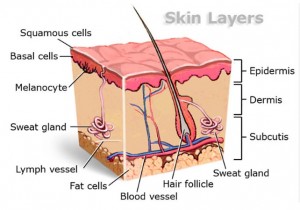 Remember the summer days when you could sit for long periods of time outdoors with the warm sun beaming down on you? Now that we are in the middle of winter, we want nothing more than to get that feeling back and to have as much sun exposure as possible.
Remember the summer days when you could sit for long periods of time outdoors with the warm sun beaming down on you? Now that we are in the middle of winter, we want nothing more than to get that feeling back and to have as much sun exposure as possible.
Some of us will escape down South to get just that but most of us will hope for those sunny winter days. Short periods of sun exposure can be healthy for our skin and overall health, but there are many things to be aware of regarding sun exposure. The South Asian community, in particular, may think they are protected from any sun related health concerns; however this is not the case.
In the South Asian community there is the perception that with deeper pigmentation and darker skin there is effective protection from the ultraviolet radiation (UV rays) which the sun emits. Yes, darker pigmentation means the skin is more protected but that does not mean that the skin cannot be harmed at all.
Having high sun exposure for long periods of time will lead to more wrinkles and age spots making the skin look many years older than it is. This increases the effects of aging and increases your risk for skin cancer. Over time, the sun???s UV rays can damage skin fibers known as elastin, which results in the skin beginning to sag, stretch, and be more prone to tearing.
This is a huge concern in many western nations that have high rates of skin cancer like in the United States and Australia. We know that UV rays are the number one cause of skin cancer in many Western nations and the increase caught much media attention when tanning beds became quite popular. The reason tanning beds became a problem was because young individuals were using tanning beds more frequently and exposure to UV rays at younger ages significantly ages the skin and increases the risk of severe skin cancer later in life.
Australia has one of the highest rates of skin cancer around the world because of the direct sun exposure based on the climate and location of Australia and because Australia???s population is mainly Caucasian. With increased sun exposure in young populations in Australia, there is a significant increase in skin cancer rates later in life as these individuals age.
Three main types of skin cancer:
Basal Cell Carcinoma ??? this can appear as a small bump or flat discoloured lesion on the skin, generally in the areas of the face, neck, legs, or arms. This is a less serious type of skin cancer and accounts for up to 95% of all skin cancers along with squamous cell carcinoma. It is highly treatable if found early.
Squamous Cell Carcinoma ??? a firm red nodule or rough lesion that may bleed easily and can appear in areas that are constantly exposed to the sun. This is a less serious type of skin cancer and accounts for up to 95% of all skin cancers along with basal cell carcinoma. It is highly treatable if found early.
Melanoma ??? presents as a pigmented patch of white or red and tends to look irregular but in the form of a mole. This is a severe skin cancer that accounts for a majority of skin cancer deaths and can spread to other organs if not treated. There are signs used to assess melanoma lesions that can be useful for self-examination.
Signs for melanoma
A ??? Asymmetry, the lesion will appear asymmetrical meaning that one half may look different from the other half
B ??? Border, edges are rough, blurred, or ragged
C ??? Colour, uneven discolouration ranging from brown, black, red, blue, white, or tan
D ??? Diameter, major changes in the size of the lesion (usually bigger than 6mm)
E ??? Evolving, any new lesions or moles that change in size, colour, or shape
Who is at risk?
Individuals who have fair skin, have more prominent freckles, or tend to burn easily are at higher risk. Also, individuals who have moles or have a history of severe sunburns are at a higher risk. Among the South Asian community, skin tones vary significantly which is a clear indication that risk also varies depending on skin tone, skin sensitivity, and sun exposure.
Protective measures
The skin can be protected and as the skin is an important organ for the body, continuous protection is needed. With ongoing and consistent sun protection, the skin is more likely to repair itself when it is damaged so protecting yourself throughout your lifetime will actually help maintain healthier skin. As we age, the skin will definitely change but we can slow down the process.
1. Apply sunscreen with an SPF of 30 or more, with UVB and UVA protection and use about 20 minutes before heading outdoors and make sure to re-apply if spending more than 2 hours outside and even more if you are swimming or sweating
2. Use UV protected cosmetics, contact lenses, and clothing
3. Wear sunglasses and hats to help protect your eyes and face
4. Avoid direct sun exposure during peak hours ??? usually from 10am to 2pm
5. Check your skin when you are exposed over time or excessively to ensure no new moles or lesions are present
Why are sunglasses important?
Your skin is not the only part of the body at risk and people often forget how the sun can affect the eyes. With sun exposure over time, the risk of cataracts will increase with age. The number of cataracts in older adults across the globe is on the rise. People often forget to protect their eyes which can be a serious concern with high sun exposure. For example, many individuals migrated to Canada from South Asia after many years of constant sun exposure. Over time many of these individuals develop cataracts in Canada because wearing sunglasses is not common practice for many. So as a tip, make sure that you and your family wear sunglasses when out in the sun.
Sun exposure in the winter months

You can still be exposed to UV rays during the winter months as UV rays can be reflected by the snow. This is more damaging when individuals are at higher altitudes and this is especially important for winter sports like skiing and snowboarding.
Sun exposure when swimming
A common misconception is that spending time in the water will mean less exposure to the sun???s UV rays. However, it is quite the opposite as spending time in the water without sun protection can be seriously harmful to the skin. The water reflects UV rays from the sun to our skin quite effectively and this can be more severe on extremely hot days and especially during peak hours from 10am to 2pm. You will not actually feel the burning until after you leave the water. Protective measures include swimming earlier in the day or in the late afternoon to avoid peak hours and by wearing sunscreen that is water resistant and making sure to re-apply every few hours.
Being knowledgeable about sun exposure will help not only you, but the community as a whole. This is not to say that all or any sun exposure is harmful as we know that some sun exposure is advantageous. But being cautious and protecting your skin will help to allow adequate sun exposure without severe skin consequences.
Jeavana Sritharan is a PhD Student in Medical Science at the University of Toronto. She is currently working with Cancer Care Ontario with the Occupational Cancer Research Centre and is the Co-Founder of the webpage, Health Perspectives. Contact email: info@healthperspectives.ca
By: Jeavana Sritharan, BHSc, MHSc, PhD Student













